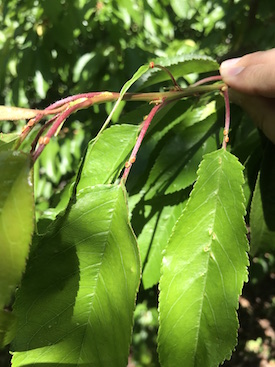 Extrafloral nectaries on the petioles of these cherry tree leaves look like rosy eggs. Photo credit M. Thompson.
Extrafloral nectaries on the petioles of these cherry tree leaves look like rosy eggs. Photo credit M. Thompson.
Question: My nectarine and peach trees have hard pale green ball things near the base of leaves. What are they and are they harmful to my trees?
Charles M., Albuquerque, NM
Answer: How cool! I’d never heard of anything like this before on trees, but when I searched online, I found that bumps like those located at the leaf base and petiole* of Prunus** species are commonly called “extrafloral nectaries” and are thought to be enticements for beneficial insects. Other plants reported to have extrafloral nectaries that we grow in New Mexico include cucumbers, ash trees, cotton, sunflowers, black locusts, willows, and the houseplants croton, cattleya orchid, and hoya.
Side notes: *A petiole is just a fancy name for the little stalk that connects a leaf to a branch. **Prunus species include the stone fruits (almonds, peaches, nectarines, cherries, apricots, plums, etc.)
In the NMSU Extension Guide H-169 “Using Insectary Plants to Attract and Sustain Beneficial Insects for Biological Pest Control”, author Dr. Ashley Bennett explains that the beneficial insects category doesn’t just include pollinators; it also includes predators (like ladybugs, aka lady beetles) as well as parasitic wasps and flies (like wasps that parasitize and kill tomato hornworms). We can strategically attract these predatory friends by incorporating plants in our gardens that are known to provide ample pollen and nectar through the entire season.
In the case of peach trees, the flowering period only lasts a few weeks and, as many sad peach lovers know all too well, only very early in the spring. Beneficial insects are needed throughout the long growing season to control pest species, so offering extrafloral nectaries is a great way to ensure that these beneficials have convincing reasons to stick around—and the sustenance to do so.
When I saw your photos of those odd bumps, I ran out to our fruit trees growing here at the NMSU Agricultural Science Center in Los Lunas to try to find some of my own. It didn’t take long. It’s odder that I’d never noticed them before. I found bright rosy twin nectary bumps on every petiole on every one of the 45 cherry trees I inspected (10 different cultivars). I didn’t find the same obvious structures on the apricots, plums, or peaches, but blister-like formations seemed to be developing at the basal leaf margin of some of the peach leaves and tiny hard green bumps on plum petioles. Whether those are not yet fully developed or some kind of vestigial remnant, I’m not sure. I’ll check through the summer to see if they change. Visit the blog version of this column for way too many petiole pics and seasonal updates here.
I can understand how someone might think these strange extrafloral nectaries are insects or evidence of a strange foliar disease. Leaf galls can look sort of similar to extrafloral nectaries as far as being wart-like protrusions. But leaf galls are formed when an insect, mite, bacteria, or other foreign organism disrupts the integrity of the leaf surface, and the plant responds to that irritation by forming a gall—kind of like a scar. Leaf galls tend to be unsightly, but not problematic, so treatment is rarely recommended. Especially on the cherry tree leaves, the extrafloral nectaries look an awful lot like insect eggs. For help identifying beneficial insects in your garden, check out the new NMSU Extension Guide H-172 that has just been released: “Backyard Beneficial Insects in New Mexico”. The PDF version is formatted to be made into a pocket-sized flipbook, and it is full of “key ID tips” and phenomenal photos, taken mostly by authors Dr. Bennett and Miranda Kersten.
Of all the things I’ve learned over the past 89 or so weeks that I’ve been publishing this gardening column (who’s counting?), these extrafloral nectaries have surprised me the most. Investigate plants in your garden or neighborhood for ambrosia pockets and contact me or tag me via social media (@NMDesertBlooms) to share what you find. Maybe you’ll find something even cooler than an extrafloral nectary, and I can feature it in next week’s column.
Send gardening questions to Southwest Yard and Garden - Attn: Dr. Marisa Thompson at desertblooms@nmsu.edu..
Please copy your County Extension Agent and indicate your county of residence when you submit your question!
For more gardening information, visit the NMSU Extension Horticulture page at Desert Blooms.


